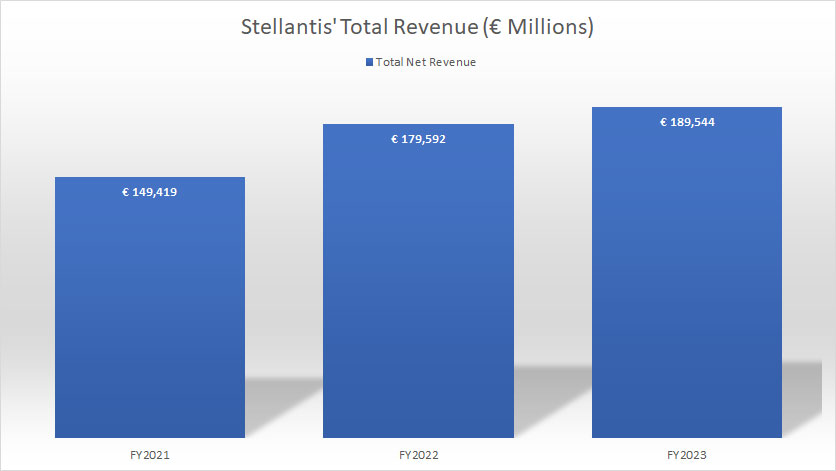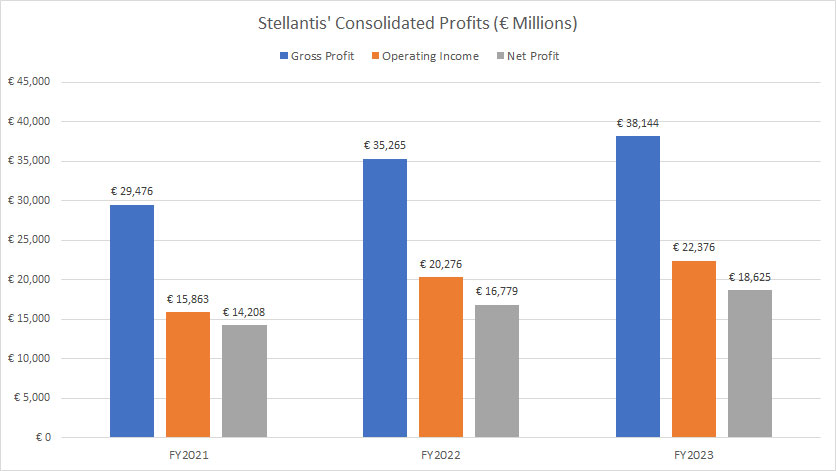
Architecture. Pixabay image.
Stellantis is a new automotive group formed by the merger of two major car manufacturers, PSA Group and Fiat Chrysler Automobiles (FCA). The merger was completed in January 2021, creating the world’s fourth-largest automaker by volume.
Stellantis has a strong presence in Europe, North America, and Latin America, with 14 iconic brands under its umbrella, including Peugeot, Citroën, Opel, Fiat, Chrysler, and Jeep.
The company aims to become a leader in the rapidly changing automotive industry by delivering innovative, sustainable, and accessible mobility solutions that meet customers’ evolving needs worldwide.
This article presents Stellantis’ worldwide revenue, vehicle shipments, revenue breakdown by type, profits and margins.
Let’s take a look!
For vehicle sales and market share of a specific region and country, you may find more information on this page: Stellantis global sales and sales by country.
Investors interested in revenue breakdown by segment and region or country may find more information on these pages: Stellantis revenue by segment and Stellantis revenue by country.
Please use the table of contents to navigate this page.
Table Of Contents
Definitions And Overview
- Vehicle Shipments
- Joint Venture
- Revenue From Vehicle Shipments & Sales Of Other Goods
- Other Services
- Construction Contract Revenue
- Leasing Revenue With Buyback Commitment
- Interest Income
O2. What Does Stellantis Do?
O3. How Does Stellantis Generate Revenue?
Worldwide Sales
Worldwide Revenue
A2. Global Revenue
Consolidated Profits And Margins
Revenue By Type
C1. Revenue From Vehicle Shipments, Sales Of Other Goods, Services, etc.
C2. Percentege Of Revenue From Vehicle Shipments, Sales Of Other Goods, Services, etc.
Conclusion And Reference
S1. Conclusion
S2. References and Credits
S3. Disclosure
Definitions
To help readers understand the content better, the following terms and glossaries have been provided.
Vehicle Shipments: Vehicle shipments correspond to vehicles shipped to dealers, distributors, fleet customers or directly to retail customers in some cases.
Revenue is recognized when control of vehicles, services or parts has been transferred, and Stellantis’ performance obligations to customers have been satisfied.
Transfer of control, and therefore revenue recognition, generally corresponds to the date when the vehicles or service parts were made available to the customer or when the vehicles or service parts were released to the carrier responsible for transporting them to the customer.
For vehicle sales and market share of a specific region and country, investors may find more information on this page: Stellantis global sales and sales by country.
Joint Venture: A joint venture refers to a business arrangement where two or more parties agree to pool their resources and expertise to carry out a specific project or business activity.
Each party contributes capital, assets, skills, and knowledge to the joint venture and shares in the risks and rewards of the venture in proportion to their respective ownership interests.
The joint venture is treated as a separate entity for accounting purposes, and financial statements are prepared to reflect its operations and performance.
The accounting treatment of a joint venture depends on the nature and structure of the venture and may involve consolidation, equity method, or proportionate consolidation.
Revenue From Vehicle Shipments & Sales Of Other Goods: Revenue from vehicle shipments refers to the income generated by a company by selling vehicles to customers and dealerships. This can include cars, trucks, buses, and other types of vehicles.
On the other hand, sales of other goods refer to the income generated by a company through the sale of non-vehicle products and services, such as automotive parts, accessories, financing services, and maintenance and repair services.
Both revenue streams are important for automotive companies, as they help to sustain their operations and support innovation and growth in the industry.
Other Services: Revenues from other services provided are primarily comprised of maintenance plans, extended warranties, and connectivity services. These services are either included in the selling price of the vehicle or separately priced.
Construction Contract Revenue: Revenue from construction contracts, which comprised of industrial automation systems, is included within “Other activities”.
Leasing Revenue With Buyback Commitment: Vehicle sales to customers can include a repurchase obligation, whereby Stellantis is required to repurchase the vehicles at a given point in time. Stellantis accounts for such sales as an operating lease.
Interest Income: Interest income is primarily generated by providing dealer and retail financing.
What Does Stellantis Do?
According to the 2023 annual report, Stellantis and its subsidiaries are engaged in the design, engineering, manufacturing, distribution and sale of automobiles and light commercial vehicles, engines, transmission systems, mobility services, metallurgical products and production systems.
In addition, Stellantis is involved in certain other activities, including software and data businesses and financial services activities relating to dealer and customer financing.
How Does Stellantis Generate Revenue?
Stellantis generates its revenue primarily through the sale of vehicles. The company produces a wide range of cars, trucks, and SUVs under various brand names, including Jeep, Ram, Chrysler, Dodge, Fiat, Peugeot, Citroën, Opel, and Vauxhall.
Stellantis also generates revenue by financing vehicle purchases, providing maintenance and repair services, and selling automotive parts and accessories.
Additionally, the company has partnerships with other companies in the automotive industry to develop new technologies and expand its reach in different markets.
Global Vehicle Shipments
Stellantis-vehicle-shipments-global
(click image to expand)
A definition of Stellantis’ vehicle shipments is available here: vehicle shipments. Basically, Stellantis’ vehicle shipments refer to vehicle wholesale the company sends to its dealerships for resale. This number determines the company’s revenue, which is recognized when the vehicles are sold to customers.
Stellantis has been selling an average of 6.1 million vehicles globally each year since 2021. This sale figure consists of consolidated shipments and shipments by joint ventures. A definition of Stellantis’ joint venture is available here: joint venture.
Stellantis’ worldwide vehicle shipments reached an all-time high of 6.4 million units in 2023, representing a 6% increase over last year.
Global Revenue
Stellantis-worldwide-revenue
(click image to expand)
Stellantis’ worldwide revenue reached €189.5 billion as of 2023, up 5.5% over 2022. Stellantis earned €149.4 billion and €179.6 billion in global revenue in fiscal years 2021 and 2022, respectively.
Stellantis generates an average annual global revenue of €172.9 billion from 2021 to 2023.
Profits
Stellantis-consolidated-profits
(click image to expand)
Stellantis has earned billions of euros in profits, with an average yearly gross profit of €34.3 billion and an operating income of €19.5 billion between 2021 and 2023. Additionally, its net profit has averaged €16.5 billion since 2021.
One noticeable trend that has emerged is the significant rise in profitability for Stellantis since 2021. For instance, the gross profit for Stellantis has increased by 29% since 2021, while the operating income has gone up by over 40% during the same period. Additionally, the net profit for Stellantis has climbed by more than 30% since 2021. In summary, Stellantis is a profitable company.
Margins
Stellantis-consolidated-margins
(click image to expand)
Stellantis has an average gross margin of 19.8% between 2021 and 2023, while the operating profit margin has averaged 11.2% during the same period. Moreover, Stellantis has an average net profit margin of 9.6% between 2021 and 2023.
Since 2021, Stellantis’ margins have steadily increased.
Revenue From Vehicle Shipments, Sales Of Other Goods, Services, etc.
Stellantis-revenue-by-type
(click image to expand)
The definitions of Stellantis’ revenue by type are available here: revenue from vehicle shipments & sales of goods, other services, construction contract revenue, leasing revenue with buyback commitment, and interest income.
Stellantis generates revenue from multiple streams, the majority of which comes from vehicle shipments and sales of other goods. This portion of revenue totaled €144.6 billion, €173.7, and €183.2 billion in fiscal years 2021, 2022, and 2023, respectively.
Apart from vehicle shipments and sales of goods, Stellantis also earns revenue from other services, primarily comprising maintenance plans, extended warranties, and connectivity services. This part of revenue reached €3.1 billion, €3.8 billion, and €4.0 billion in fiscal years 2021, 2022, and 2023, respectively.
Stellantis’ construction contract revenue, derived from building industrial automation systems, reached €602 million, €779 million, and €709 million in fiscal years 2021, 2022, and 2023, respectively.
Stellantis’ other revenue sources, which include leasing and interest income, came to about €896 million and €691 million in fiscal 2023, respectively.
Percentage Of Revenue From Vehicle Shipments, Sales Of Other Goods, Services, etc.
Stellantis-revenue-by-type-in-percentage
(click image to expand)
The definitions of Stellantis’ revenue by type are available here: revenue from vehicle shipments & sales of goods, other services, construction contract revenue, leasing revenue with buyback commitment, and interest income.
Stellantis’ vehicle shipments and sales of other goods have consistently contributed over 96% of revenue to the company. This sales category made up 96.7% of the company’s total revenue in fiscal year 2023.
On the other hand, Stellantis’ other services contribute only about 2% of sales to the company. This revenue category accounted for only 2.1% of total revenue in fiscal 2023.
Stellantis’ other revenue sources, which include construction contract revenue, leasing and interest income, make up only a very small portion of the company’s total revenue. Together, they accounted for only about 1% of total revenue in 2023.
Conclusion
Stellantis is a profitable company, with annual revenue reaching nearly €190 billion in fiscal 2023. Stellantis ships an average of 6 million vehicles globally per year.
Stellantis generates billions of euros in profits and derives the majority of its revenue from sales of vehicles and other goods.
References and Credits
1. All financial figures presented in this article were obtained and referenced from Stellantis’ quarterly and annual reports, SEC filings, investor presentations, press releases, earnings reports, etc., which are available in Stellantis Investor Relation.
2. Pixabay images.
Disclosure
References and examples such as tables, charts, and diagrams are constantly reviewed to avoid errors, but we cannot warrant the total correctness of all content.
The content in this article is for informational purposes only and is neither a recommendation nor a piece of financial advice to purchase a stock.
If you find the information in this article helpful, please consider sharing it on social media and provide a link to it from any website to create more articles like this.
Thank you!






